skip to main |
skip to sidebar
This is the eleventh of a group of posts describing an 'Expedition Cruise' with Noble Caledonia in 2020 under the title 'Across the Tropic of Capricorn'.
Events of Friday 21st February 2020
The visit to Ureparapara was added to the programme only two days previously, when Noble Caledonia decided that the planned visits to the Solomon Islands were no longer viable. Overnight, the ship had sailed from our previous mooring off Ambryn Island around 170 nautical miles to Ureparapara.
The island is a large, volcanic caldera which has collapsed on one side, allowing the surrounding sea to flood the cone, producing a horse-shoe shaped island. Deception Island in Antarctica (which I’ve visited a couple of times in 2007 and then 2016) has similar origins.
Many of the passengers were on deck as the ship made its entrance to the caldera at Ureparapara.

View from 'Caledonian Sky' as we approach the flooded caldera: Ureparapara, Vanuatu.
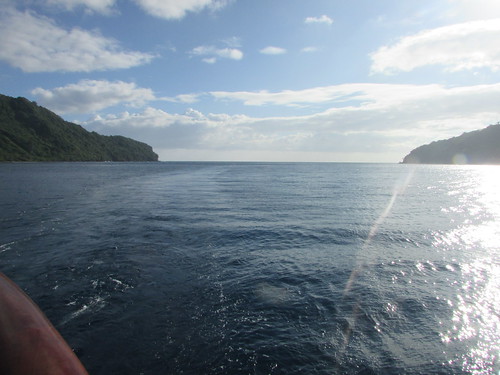
View of open sea from 'Caledonian Sky', inside the flooded caldera: Ureparapara, Vanuatu.
At 08:45, the ship started taking passengers ashore by Zodiac for a wet landing into the shallows of a narrow beach area of black, sticky mud-like volcanic sand.

View from Zodiac as we go ashore at Ureparapara, Vanuatu.
A group of impressive male dancers welcomed us, moving to the beat of a hand-held percussion bamboo instrument. All the men were painted all over in black with white rings around torso, arms and legs. They wore grass skirts and large clusters of sea shells around each ankle, producing a distinctive accompaniment as they stamped the ground. Young children from the village nearby watched the proceedings with interest.

Male dancers painted all over in black with white rings around torso, arms and legs on Ureparapara, Vanuatu.

A group of children on Ureparapara, Vanuatu.
Nearby, a group of more modern musicians were playing and singing. There was one bongo drummer, three acoustic guitars and one small 4-string banjo-like locally-made instrument. Like almost all the men, they were dressed in colourful tee-shirts with shorts but the musicians were also adorned with headbands carrying hibiscus flowers.
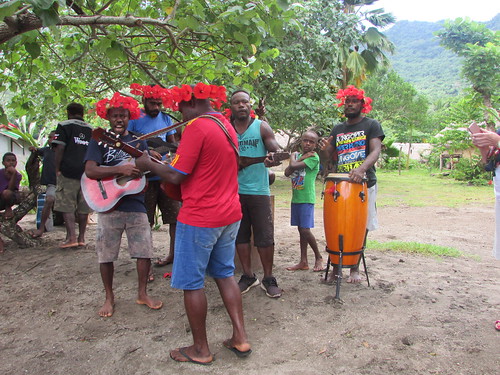
A group of modern musicians playing and singing on Ureparapara, Vanuatu.
There had been a ‘USAID’ project here for a large sign carried the project title ‘Land and Vegetation Cover and Improving Food Security for Building Resilience to a Changing Climate in Pacific Island Communities’. The rest of the sign was in Bismala, the Pidjin language widely understood in Vanuatu. There's a list of English-based Pidjins on Wikipedia here and Bislama is discussed in the interesting Wikipedia article here.
We walked towards the village, where the most buildings were timber framed, with woven bamboo walls and thatched roofs, either erected on a small plinth of flat stones or lifted a few inches above the ground.

House under construction, Ureparapara, Vanuatu

Ureparapara, Vanuatu.
The church of Saint Barnabas was a slightly more substantial construction with a sawn timber frame and corrugated sheet roof but still retaining woven bamboo panels for the walls. A large gas cylinder standing vertically nearby served as the church bell.
A group of kneeling young boys in grass skirts were playing a pebble-tossing game in a small, square area marked-out by four straight poles.
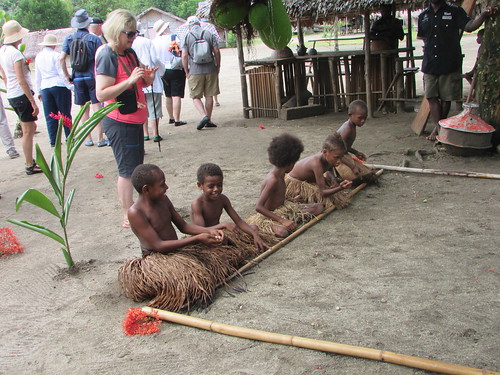
Young boys playing a pebble-tossing game on Ureparapara, Vanuatu.
All the visitors were seated in wooden stands around a performance area. The end bench seat quite near me suddenly collapsed as people tried to sit.

Collapse of bench seat, Ureparapara, Vanuatu.
Various locally-made benches and chairs quickly appeared and everybody was successfully seated. I couldn't resist the suspicion that this minor incident was symptomatic of a laid-back approach to life by the hospitable islanders.
First, a group of nine ladies in grass skirts danced for us.

Female dancers, Ureparapara, Vanuatu
Next, three men formed a percussion band. The hand-held bamboo instrument we’d seen as we arrived was now fixed between two waist-high poles and supplemented by two other musicians - one with what looked like some sort of gourd with seeds inside which was shaken and the other with a long pole held upright and struck against a baseplate laid on the ground. In the meantime, the ladies had each armed themselves with bamboo staffs.

Lady dancers chat as three musicians prepare: Ureparapara, Vanuatu.
Ten male dancers then performed, all wearing grass skirts with a thin cloak made from long plant fronds and with clusters of sea shells around each ankle. Each wore distinctive headgear, representing different aspects of life on the island.

Ten male dancers, each with headgear representing different aspects of life on Ureparapara, Vanuatu.
The ship's passengers then continued to explore the village. Another band started to play. The musicians were in modern dress but plus the thin cloak made from plant fronds. The line-up was drummer, two men each playing a sort of Pan-Pipe with four notes and four men each playing an instrument similar to a xylophone comprising ten bamboo pipes, each a different length, assembled together on an inclined frame. The note was struck by striking the open top of the desired bamboo pipe with a paddle. The overall effect was splendid.

The Band: Drum, Pan Pipes and four bamboo xylophones: Ureparapara, Vanuatu.
At a shelter next to the band, fruit and fresh coconut milk was offered to the visitors. A couple with a child, all in traditional dress, prepared a local dish, inevitably involving coconut, which was then offered to the ship’s passengers.

A couple with a child offered local food to the visitors: Ureparapara, Vanuatu.
Near the sea, an elaborate diagrammatic map of the village had been created with pebbles set in clean sand, decorated with hibiscus and other blooms. I presume the 'Store' is what the the english call a 'Shop'. The 'Nakamal' is the men's hut where men relax and drink Kava. I assume 'Keeping House' refers to a store house.
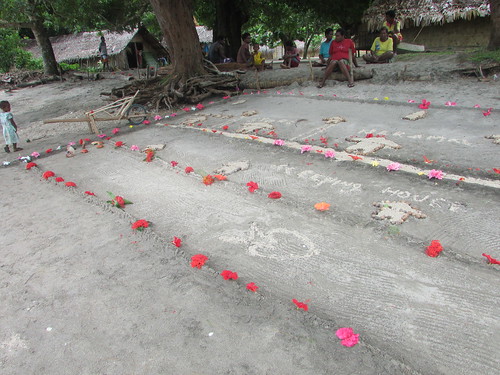
A diagrammatic map of the village had been created with pebbles set in raked sand: Ureparapara, Vanuatu.
It was a very friendly, relaxed visit and we spent some time just chatting to the villagers and listening to the live music. Eventually we moved towards the Zodiac landing place and, by noon, we had transferred back to the ship after a very enjoyable visit to Ureparapara.
Related posts on this website
This post is in the series labelled 'Tropic of Capricorn’. The first post is here.
Clicking on the 'Next report' link will display the post describing the next events. In this way, you may read about the trip in sequence.
Next report
Alternately, clicking on the 'All my Tropic of Capricorn reports' link displays all the posts on this trip in reverse date-of-posting order.
All my Tropic of Capricorn reports
My pictures
This blog post was first published on the ship via a satellite link with limited capacity so the link to my pictures was added later.
Ureparapara, Vanuatu
[Link to pictures added 11-Mar-2020: Pictures embedded 31-Mar-2020]
This is the tenth of a group of posts describing an 'Expedition Cruise' with Noble Caledonia in 2020 under the title 'Across the Tropic of Capricorn'.
Events of Thursday 20th February 2020
The visit to Ambrym Island was added to the programme only on the previous day, when Noble Caledonia decided that the planned visits to the Solomon Islands were no longer viable. Overnight, the ship sailed to Ambrym and moored off the island at around 07:00.
At 08:30, after breakfast, Zodiacs started to ferry guests ashore for a wet landing onto a beach of black sand. Two parallel rows of long-stemmed flowers had been set in the sand by local ladies who presented us with beautifully-made leaf necklaces and directed us along a track to a performance area surrounded by fairly rickety bench seating where we were to witness the traditional and highly symbolic Rom or ‘Masked’ Dance.
There was one grave in the performance area, I believe that of a former Chief, bestrewn with flower petals. The present Chiefs, dressed in the traditional 'namba' (a penis sheath) formally greeted the Ship’s Captain, the Expedition Leader and the Local Tour Company Staff who had organized the event.

The Ship's Captain is welcomed by the local Headman: Ambrym, Vanuatu.
Then, the male dancers, all dressed in traditional 'namba' stamped and moved mystically for some time at a distance from the audience to the beat of a hand-held percussion instrument carried by the elderly chief.
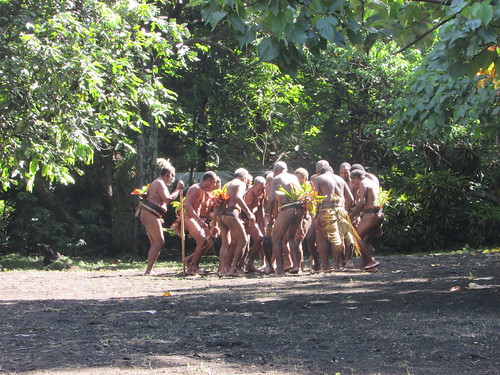
The male dancers stamped and moved mystically: Ambrym, Vanuatu.
Then, the dancers were surrounded by elaborately-masked ‘devils’ in voluminous cloaks of banana leaves who twirled around the dancers, beating the ground with symbolic long staves. The whole group moved towards the centre and the ritual continued until the male dancers retired, leaving the ‘devils’ to pirouette alone.

Elaborately-masked ‘devils’ in the Rom Dance: Ambrym, Vanuatu.

Male dancers being surrounded by elaborately-masked ‘devils’: Ambrym, Vanuatu.

Male dancers completely surrounded by ‘devils’: Ambrym, Vanuatu.
Finally, the ‘devils’ retired and the male dancers, rather unexpectedly, quietly lined up for photographs.

Male dancers relax after the Rom Dance: Ambrym, Vanuatu.
One chief then performed a sombre melody on a long bamboo flute with a series of holes to allow different notes to be played.
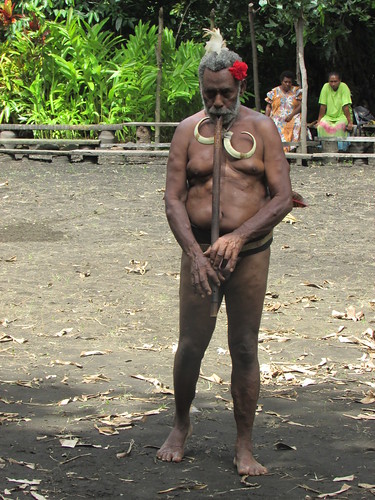
A sombre melody on a long bamboo flute: Ambrym, Vanuatu
To demonstrate the Ambrym tradition of sand drawing, assistants then spread sand on one area near the grave and a second spot in the performance area. Two of the male dancers we'd watched then showed their skill at sand drawing, each smoothing the sand to their satisfaction before swiftly scribing a stylized image of remarkable complexity.

Sand Drawing: Ambrym, Vanuatu
The final item was a demonstration of 'magic'. Two men with woven baskets faced one another. The first showed that his basket held six large nuts, whilst other basket held none. The first man then pretended to throw an imaginary nut from his basket to the second man who caught it in his basket. This continued until six imaginary nuts had been transferred. The first man inverted his basket to show that his basket was now empty then the second man showed that his basket now contained six large nuts!
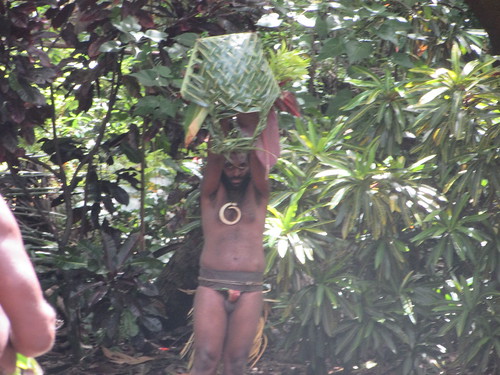
The first magician displays his now 'empty' woven basket: Ambrym, Vanuatu.
The whole performance had been quite impressive, if inscrutable. Seeking more understanding on my return, I found that the Vanuatu Tourism Office offers the exact programme we saw as "A sacred event associated with magic believed to influence harvests. You will watch hypnotic costumed dances and listen to beautiful and haunting bamboo flute music. You will witness a small display of mysterious ‘Black Magic’ only performed by special sorcerers – ‘the man blong blak majik’".
We then walked to the quiet village which showed a wide variety of building styles. Some houses had a wooden frame made from sawn timber, lifting the floor a few feet off the ground. The walls were woven bamboo topped by a thatched roof. Other dwellings of similar construction placed the floor at ground level. Elderly store houses had stone walls and corrugated sheet roofing but there was also one large, timber framed store with corrugated sheet roof. There were some stone plinths, presumably the relics of older buildings and at least one abandoned cement-lined stone cistern. The village seemed to have lots of derelict buildings. One more modern section of an abandoned building had a formed concrete foundation, with blockwork above, stabilized by vertical reinforcing bar with concrete poured into the spaces through the blocks.

Large house overlooking the sea - traditional but elevated on reinforced concrete piles: Ambrym, Vanuatu.
Lonbato Co-operative Society shop was quite modern and we went inside to study the wide range of stock held. There was a large array of solar panels outside.

Expedition Leader Craig Ward surveys the stock in Lonbato Cooperative Society shop: Ambrym, Vanuatu.
The Church was a large, modern building near Lonbato Co-op. Inside, on a large blackboard, the forthcoming programme of events and the draft budget had been chalked up. Behind this building I found what was apparently the original church building, now disused. A simple wooden frame still suspended a large gas cylinder, struck to call the faithful.

Ambrym, Vanuatu, showing old church, new church and church bell.
A loud thump behind me made me spin round. A large, heavy, ripe breadfruit had just fallen to the ground, uncomfortably close to me.

A ripe breadfruit falling from a tree just missed me.
Unharmed, I returned to our point of landing where a selection of beautiful polished hardwood carvings were on sale. After a fascinating morning, our Zodiacs returned us to the ship to be presented with yet another comprehensive and tempting lunch menu.

Jan, on return to ship with beautifully-made leaf necklace from Ambrym.
As we lunched, the ship repositioned off the village of Ranvetlam. The first Zodiac departures took swimmers and snorkelers ashore then the other Zodiacs Zodiacs offered the remaining passengers a one hour cruise looking at features along the coastline.

Zodiac Cruise, Ambrym
Along this part of the coast, there was no beach and the land met the sea at a 15 foot rock cliff. A stream tumbled over this cliff in a waterfall. Village women had completed washing clothes in this stream and had spread out the items on the rocks to dry in the sun, allowing a group of young children to splash around happily in the stream.

Village children watch their visitors: Zodiac Cruise, Ambrym.
Further along, the cliff was pierced by a series of shallow caves and the Zodiacs carefully nudged inside. Shortly afterwards, the Zodiac I was in suffered a fuel blockage. Having confirmed the plastic fuel tank in the locker in the bow had plenty of fuel, our driver tried hand priming by squeezing the fuel bulb a number of times but without success. Seeking fault-finding tips over the radio, our driver was told to try stamping firmly on the fuel bulb a few times and this technique was successful.
A shoal of tuna was spotted in a feeding frenzy, members leaping out of the water in their excitement. By then, it was time to return to the ship after an interesting interlude. With everybody safely back on board, and the Zodiacs stowed by about 17:30, the Captain was able to start our overnight journey to Ureparapara, third largest Island of the Banks Island chain in Vanuatu.
Related posts on this website
This post is in the series labelled 'Tropic of Capricorn’. The first post is here.
Clicking on the 'Next report' link will display the post describing the next events. In this way, you may read about the trip in sequence.
Next report
Alternately, clicking on the 'All my Tropic of Capricorn reports' link displays all the posts on this trip in reverse date-of-posting order.
All my Tropic of Capricorn reports
My pictures
This blog post was first published on the ship via a satellite link with limited capacity so the links to my pictures were added later.
Ambrym, Vanuatu
Zodiac Cruise, Ambrym, Vanuatu
[Links to pictures added 11-Mar-2020: Pictures embedded 01-Apr-2020]
This is the ninth of a group of posts describing an 'Expedition Cruise' with Noble Caledonia in 2020 under the title 'Across the Tropic of Capricorn'.
Events of Wednesday 19th February 2020
Whilst the guests slept, ‘Caledonian Sky’ sailed to the large island of Espiritu Santo in Vanuatu and about 7 a.m. berthed at the small, modern main quay at Luganville. Two modern transit sheds and stacks of shipping containers just two high confirmed that the quay was the main point for transferring containers between vessel and shore. Two spreader beams (for 40 foot and 20 foot containers) were on the quay, but the expected mobile crane for handling containers (usually in the form of a Reach Stacker at smaller installations) was not visible. At the end of the quay, a covered walkway led up to a modern, brick building which I assumed was used as port offices and passenger terminal for cruise ships.

The quay at Luganville, Espiritu Santo. Note the Transit Shed, substantial bollard, yellow spreader beams, 20 foot container park and, in background, covered walkway to terminal/office building.
I watched, with interest, as members of the ship's crew, assisted by local dock workers, deployed the port side gangway. As they completed the task, a fleet of at least ten people carriers entered the port and lined up on the quay

Members of the ship's crew, assisted by local dock workers, deployed the port side gangway: Luganville, Espiritu Santo

The fleet of people-carriers lined up on the quay: Luganville, Espiritu Santo
After an earlier breakfast, starting at 06:30, a small, energetic group of guests group who fancied river kayaking left by private bus to drive to the kayak pick-up point. The majority of passengers chose to join the waiting fleet of private buses, to the cheerful accompaniment of a local band. I particularly liked the one-string double bass made from a tea chest.
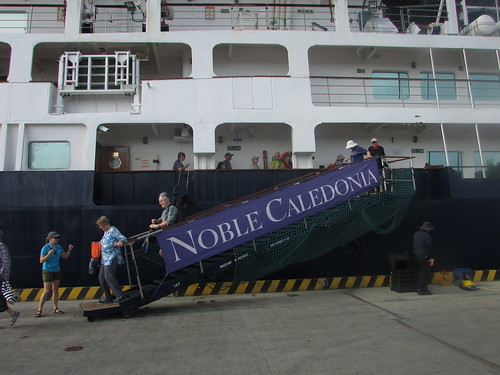
Passengers disembarking at Luganville, Espiritu Santo

A local band welcomed us ashore at Luganville, Espiritu Santo.
When all the passengers had been sorted into the appropriate coach according to which option they preferred after visiting the Cultural Village, the procession of vehicles drove out of the port, turned away from the town and took the road for Leweton Cultural Village.
I’m normally put off by ‘touristy’ cultural villages but I found the visit interesting. A group of dark-skinned warriors and young boys were on hand to alternately threaten us with spears or pose for our photographs.

Leweton Cultural Village, Luganville
We were led to an arena with substantial seating including a thatched roof where a lady in a voluminous skirt and top made from leaves gave some explanation of the demonstrations we were about to watch.
One of the men started to prepare the local drink ‘kava’ by laboriously pounding the vegetable root which is the active ingredient into a grey paste. This paste was then carefully filtered with water through cloth a number of times to produce a whitish liquid. We were told that imbibing the product quickly numbs the lips and few visitors accepted the offer to sample the product from small, half-coconut shells, but I had a couple of sips and thought the flavor ‘odd’. It didn’t compare with any flavour I was familiar with and. Having only taken a small amount, I only noticed a slight numbness around the mouth which quickly passed.

Preparing Kava: Leweton Cultural Village, Luganville.
There was then an impressive demonstration of creating fire using two pieces of carefully-selected wood. A groove in a large, straight piece laid on the ground was rubbed vigorously with a small stick and the smouldering produced was transferred to dried grass allowing a decent fire to result.
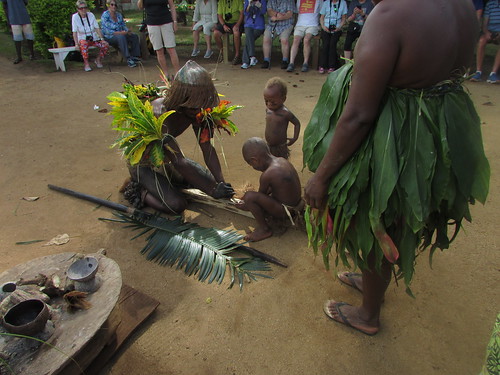
Making fire: Leweton Cultural Village, Luganville.
Traditional dances followed, performed first by ladies, then by the colourful male warriors.

Ladies Traditional Dance: Leweton Cultural Village, Luganville.

Men's Traditional Dance: Leweton Cultural Village, Luganville.
For the climax of the show, we moved to a second arena, the centerpiece of which was a deep, blue-tiled swimming pool, complete with semi-circular access steps where a group of six ladies in skirt and top made from leaves plus three young girls stood waist deep in pool water and performed ‘Water Music’. On the shouted command from the leader, the ladies beat the water in synchronism, producing different notes by scooping water sideways with their forearms or striking downwards with their palms, producing an effective, simple tune lasting around twenty seconds. They demonstrated a number of tunes for us, each separated by a short recovery period. I was charmed and delighted by it (if a trifle splashed!).


Water Music: Leweton Cultural Village, Luganville.
Some of our party then continued by bus to Million Dollar Point for snorkelling but most of us continued by bus to Riri Blue Hole, a well-known swimming location supplied by an underground fresh water spring described as “refreshingly cool and set in an exquisite tropical setting of lush jungle” and, allegedly, blue. I’m afraid this location failed to impress me.
We retraced our outward route some 23 km to Luganville town where we had around 45 minutes to explore the covered market and surrounding area. It was rather late in the day to be visiting a market and many stalls had packed-up for the day and not much selling seemed to be going on in the market but I explored the single shopping street as far as time allowed, passing Luganville Municipality Offices (single storey but with, in effect, a porte-cochere tacked on the front, large and modern which at first I took to be a petrol filling station), the small Sanma Police Patrol Office (with solar powered loudspeakers for sounding a Tsunami Warning) and a recreation ground next to the shore with a covered stage (apparently a recent legacy from the 39th Independence Day Celebration). It’s easy to forget that Vanuatu, once French controlled, only obtained sovereignty in 1980.

Market, Luganville, Espiritu Santo.

Municipality Offices, single storey with modern 'porte-cochere': Luganville, Espiritu Santo.

Recreation Ground with covered stage next to the shore: Luganville, Espiritu Santo.
Our buses picked us up and returned us to the ship, passing a long line of shops, banks, travel offices, and the Northern District Police Headquarters. The skiffle band which has welcomed us on the quay when we disembarked were there to play again.
I took lunch on the Lido deck so that, as the ship left Luganville, I could check the other port facilities. Powerful-looking Vanuatu Police Launch ‘Tukoro’ (registered in Port Vila) had moored ahead of us during our excursion ashore, as had the larger Australian Navy ship ‘Leeuwin’, A245.

Vanuatu Police Launch ‘Tukoro’: Luganville, Espiritu Santo

Australian Navy ship ‘Leeuwin’, A245: Luganville, Espiritu Santo.
We passed an older quay still home to a couple of small car ferries and motley craft but the larger vehicle/passenger ship with a stern loading door marked ‘VANUATU FERRY’ which had been moored on our arrival had already left. Next, neatly laid out on the hillside was the oil storage depot and, finally, another old quay storing containers with an adjacent modern warehouse building still under construction.
Whilst we enjoyed lunch, the ship completed the repositioning by 36 km to a spot off Champagne Beach. As the Zodiacs took us ashore, I noted that we appeared to be following a marked channel, suggesting that this might be a popular destination. We made a wet landing over the bow of the Zodiac into warm water and warm, yielding white sand. A snorkel area was indicated on one side of the landing, the swimming area on the other, extending around the wide sweep of the very attractive bay. A large structure with blue painted blockwork lower walls, plaited bamboo upper walls and thatched roof proudly proclaimed “Welcome to Champagne Beach Bar”. There were a few visitors not from the ship already there and the site appeared to enjoy road access.
I stored my shoes at the base of a fallen tree near the landing site, turned the legs of my slacks above the knee and solemnly walked along the sea margin about halfway along the very pretty bay. On my return, the ship’s catering staff were offering drinks but the offered ‘sparkling wine’ didn’t seem to match the name of the beach so I instead accepted a classic Coke.

Champagne Beach, Espiritu Santo.
Most of the guests seemed delighted with the spot but I'm afraid I prefer the properly remote. The Zodiacs returned the passengers to the ship and the ship made ready to sail to the Solomon Islands. I explained in an earlier post here how the spread of the ‘Coronavirus’ had caused an increasing number of countries has started to tighten their entry qualifications for travellers, many imposing a 14-day ‘quarantine’ between leaving a country with a confirmed ‘Coronavirus’ infection and seeking entry to the new country. We had already lost our planned day visiting New Caledonia. Further difficulties arose as we left Vanuatu for our five planned days touring the Solomon Islands. A few weeks before the start of the tour, Solomon Islands had demanded that travellers carried evidence of Measles Vaccination because of an outbreak of measles in the territory. Many of the passengers, including the writer, had to rustle round getting vaccinated because, for the age group of most of the passengers, infection during childhood was regarded as conferring immunity and formal vaccination was not required.
After we had sailed, the Solomon Islands Authorities had decided to impose the ’14-day Quarantine Rule’ for ‘Coronavirus’ which, they calculated, would make travellers via Singapore ineligible for entry on the planned date. But, if entry were later, Noble Caledonia argued that the balance of the tour would be delayed. There was some negotiation between Noble Caledonia and the Solomon Islands Authorities but the travel company decided that the whole five-day programme would have to be deleted and that the ship would spend two additional days within Vanuatu before proceeding directly to Rabaul on Papua New Guinea, missing all the planned Solomon Islands destinations.
Afterword
When I returned home, I found out a little more about the 'Kava' we'd been offered at Leweton Cultural Village. Wikipedia has a comprehensive article here but the most intriguing description of Kava was in the blog here, produced by the Bula Kava House of Portland, Oregon who operate both a bar and on-line sales of Kava!
Related posts on this website
This post is in the series labelled 'Tropic of Capricorn’. The first post is here.
Clicking on the 'Next report' link will display the post describing the next events. In this way, you may read about the trip in sequence.
Next report
Alternately, clicking on the 'All my Tropic of Capricorn reports' link displays all the posts on this trip in reverse date-of-posting order.
All my Tropic of Capricorn reports
My pictures
This blog post was first published on the ship via a satellite link with limited capacity so the links to my pictures were added later.
Luganville, Espiritu Santo
Leweton Cultural Village, Luganville, Espiritu Santo
[Champagne Beach added 25/02/2020: Link to pictures added 10-Mar-2020: Minor edits, pictures embedded 5-Apr-2020]


















































